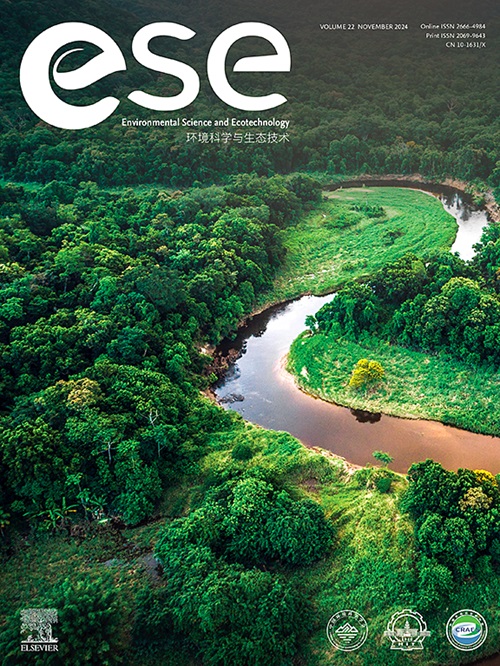Insect farming: A bioeconomy-based opportunity to revalorize plastic wastes
IF 14
1区 环境科学与生态学
Q1 ENVIRONMENTAL SCIENCES
引用次数: 0
Abstract
Managing plastic waste is one of the greatest challenges humanity faces in the coming years. Current strategies—landfilling, incineration, and recycling—remain insufficient or pose significant environmental concerns, failing to address the growing volume of plastic residues discharged into the environment. Recently, increasing attention has focused on the potential of certain insect larvae species to chew, consume, and partially biodegrade synthetic polymers such as polystyrene and polyethylene, offering novel biotechnological opportunities for plastic waste management. However, insect-assisted plastic depolymerization is incomplete, leaving significant amounts of microplastics in the frass (or manure), limiting its use as a soil amendment. In this perspective, we propose a novel two-step bioconversion system to overcome these limitations, using insects to sustainably manage plastic waste while revalorizing its by-products (frass). The first step involves pyrolyzing microplastic-containing frass from mealworms (Tenebrio molitor larvae) fed on plastic-rich diets to produce biochar with enhanced adsorptive properties. The second stage integrates this biochar into the entomocomposting of organic residues, such as food waste, using black soldier fly (Hermetia illucens) larvae to produce nutrient-rich substrates enriched with carbon and nitrogen. This integrated system offers a potential framework for large-scale industrial applications, contributing to the bioeconomy by addressing both plastic waste and organic residue management. We critically examine the advantages and limitations of the proposed system based on current literature on biochar technology and entomocomposting. Key challenges and research opportunities are identified, particularly concerning the physiological and toxicological processes involved, to guide future efforts aimed at ensuring the scalability and sustainability of this innovative approach.

昆虫养殖:一个以生物经济为基础的机会来重新评估塑料废物。
管理塑料垃圾是未来几年人类面临的最大挑战之一。目前的策略-填埋,焚烧和回收-仍然不够充分或造成严重的环境问题,未能解决日益增长的塑料残留物排放到环境中。最近,人们越来越关注某些昆虫幼虫物种咀嚼、消耗和部分生物降解合成聚合物(如聚苯乙烯和聚乙烯)的潜力,这为塑料废物管理提供了新的生物技术机会。然而,昆虫辅助的塑料解聚是不完全的,在草(或粪肥)中留下了大量的微塑料,限制了其作为土壤改良剂的使用。从这个角度来看,我们提出了一种新的两步生物转化系统来克服这些限制,利用昆虫可持续地管理塑料废物,同时重新评估其副产品(废料)。第一步涉及热解来自粉虫(黄粉虫幼虫)的含有微塑料的碎屑,这些粉虫以富含塑料的食物为食,以产生具有增强吸附性能的生物炭。第二阶段将这种生物炭整合到有机残留物(如食物垃圾)的昆虫堆肥中,使用黑兵蝇(Hermetia illucens)幼虫生产富含碳和氮的营养丰富的基质。这一综合系统为大规模工业应用提供了一个潜在的框架,通过解决塑料废物和有机残留物管理问题,为生物经济做出贡献。我们根据目前关于生物炭技术和昆虫堆肥的文献,批判性地研究了所提出系统的优点和局限性。确定了主要挑战和研究机会,特别是有关所涉及的生理和毒理学过程,以指导旨在确保这种创新方法的可扩展性和可持续性的未来努力。
本文章由计算机程序翻译,如有差异,请以英文原文为准。
求助全文
约1分钟内获得全文
求助全文
来源期刊

Environmental Science and Ecotechnology
Multiple-
CiteScore
20.40
自引率
6.30%
发文量
11
审稿时长
18 days
期刊介绍:
Environmental Science & Ecotechnology (ESE) is an international, open-access journal publishing original research in environmental science, engineering, ecotechnology, and related fields. Authors publishing in ESE can immediately, permanently, and freely share their work. They have license options and retain copyright. Published by Elsevier, ESE is co-organized by the Chinese Society for Environmental Sciences, Harbin Institute of Technology, and the Chinese Research Academy of Environmental Sciences, under the supervision of the China Association for Science and Technology.
 求助内容:
求助内容: 应助结果提醒方式:
应助结果提醒方式:


